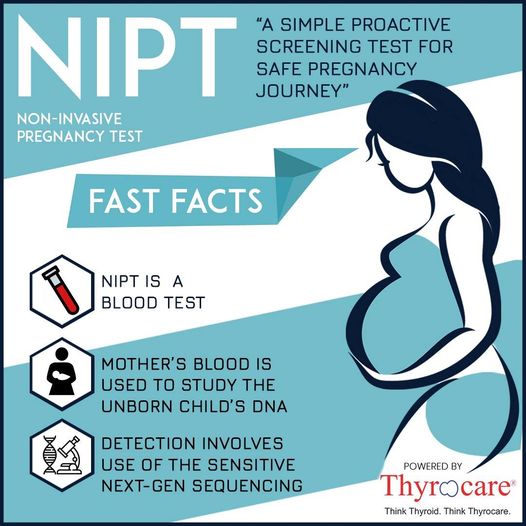May 30 (Punjab Khabarnama) : Non-invasive prenatal testing (NIPT), also known as non-invasive prenatal screening (NIPS), is an advanced genetic screening test used during pregnancy to assess the risk of certain genetic conditions or chromosomal abnormalities in the fetus like Down syndrome, Edwards syndrome and Patau syndrome. NIPT/NIPS is performed using a simple blood test from the pregnant women, which analyzes fetal DNA that is circulating in their bloodstream where about 20 ml of mother’s blood is taken for the test and the result is available in about 10 days.
In an interview with HT Lifestyle, Dr Chetna Jain, Director Dept of Obstetrics and Gynecology at Cloudnine Group of Hospitals in Gurgaon Sector 14, gushed, “NIPT/NIPS has revolutionised the care of pregnant women. It analyses cell free fetal DNA which is circulating in mother’s blood. This test can be done from 10 weeks of pregnancy. Traditionally, double markers were used as a screening test for Down syndrome between 11 to 13 weeks of pregnancy as first trimester serum (blood) screening. It has a detection rate of about 80%. When combined with nuchal scan, the detection rates are about 90% with a 5% false positive. This means about 5 % women will test positive even if their baby is normal and would need further invasive testing. Quadruple marker is a second trimester screening test for Down syndrome. It is performed between 15 to 22 weeks. It has a detection rate of 80% for Down syndrome with 5% false positive.”
Purpose:
Dr Chetna Jain revealed that NIPT/NIPS is primarily used to screen for common chromosomal conditions in the fetus, particularly –
- Trisomy 21 (Down syndrome): This is caused by an extra copy of chromosome 21.
- Trisomy 18 (Edwards syndrome): This is caused by an extra copy of chromosome 18.
- Trisomy 13 (Patau syndrome): This is caused by an extra copy of chromosome 13.
- Sex chromosome abnormalities: NIPT/NIPS can also screen for conditions such as Turner syndrome (monosomy X) or Klinefelter syndrome (XXY).
How It Works:
Dr Chetna Jain shared, “During pregnancy, a small amount of fetal DNA is naturally released into the pregnant women’s bloodstream. NIPT/NIPS uses a maternal blood sample to isolate and analyze this fetal DNA. By examining the relative amounts of different chromosomes or specific genetic markers, the test can estimate the risk of certain chromosomal abnormalities.”
Advantages:
- Non-invasive: NIPT/NIPS does not pose any risk of miscarriage because it only requires a blood sample from the pregnant person.
- High Accuracy: NIPT/NIPS has a high detection rate for common chromosomal conditions, particularly Down syndrome, with lower false-positive rates compared to traditional screening tests like maternal serum screening (e.g., quad screen).
- Early Detection: NIPT/NIPS can be performed as early as 9-10 weeks of pregnancy, providing earlier results compared to other diagnostic tests like amniocentesis or chorionic villus sampling (CVS).
How accurate is NIPT/NIPS?
Dr Chetna Jain answered, “NIPT is highly accurate. The detection rate of Down syndrome is 99%, 96% for Trisomy 18 and 91% for Trisomy 13. NIPT has highest detection achieved by any noninvasive test. A combined assessment with ultrasound and an NIPT significantly reduces the need for invasive procedures like Amniocentesis.” She elaborated –
- False positive NIPT: The accuracy of NIPT is 99% for Down syndrome. The chances for false positive is rare. More data is required to quote exact figures.
- False negative NIPT is very rare, about 0.02% to 0.2% in detecting autosomal chromosomal conditions like Down syndrome.
Risks associated with NIPT:
According to Dr Chetna Jain, NIPT has zero risk of miscarriage. CVS procedure has a miscarriage risk of 0.5 to 1%. Amniocentesis has a miscarriage risk of 0.25 to 0.5%.
Limitations and considerations of NIPT:
- NIPT has reduced sensitivity for twin pregnancy. It is not available for triplets or higher order multiple pregnancies.
- It is not available for other genetic conditions like cystic fibrosis.
It can give false positive or false negative results. - It is not available for women who themselves have Down syndrome, balanced chromosomal translocations or cancer.
- Women with organ transplant or blood transfusion in last 4 months cannot do it.
NIPT cannot screen for all chromosomal conditions. Not all NIPT panels screen for conditions related to sex chromosomes like Turners, Klinefelter and Triple X syndrome. - Since NIPT is a screening test, for all positive cases a diagnostic test is recommended for confirmation which is CVS or Amniocentesis. A pregnancy can’t be terminated based on a screen positive NIPT result.
Who should do NIPT?
Dr Chetna Jain informed, “NIPT is offered to all pregnant women from 10 wks in the USA, even to low risk population. It should be offered and considered by women where maternal age is > 35 years, ultrasound shows abnormal findings, or there is a family or personal history of chromosomal abnormality.”
Limitations:
- Any pregnant women undergoing NIPT should understand that though this is the best screening test available to date, it can have false positives and false negatives. Any abnormal result would require a further invasive testing by Amniocentesis or CVS.
- It is important for prospective parents in early pregnancy to have enough information on NIPT. With advances in technology, in future more conditions will be identified by noninvasive testing. As of today, NIPT is having a glorious triumph above all noninvasive screening tests.
Considerations:
- NIPT/NIPS results should be interpreted by a qualified healthcare provider who can discuss the implications of positive or abnormal findings and guide further diagnostic testing if necessary.
- NIPT/NIPS is optional and is offered to pregnant individuals based on their personal preferences and risk factors.
In summary, NIPT/NIPS is a valuable prenatal screening tool that offers non-invasive assessment of fetal genetic risk for common chromosomal conditions during pregnancy. It provides early and accurate information that can guide subsequent prenatal care and decision-making.

